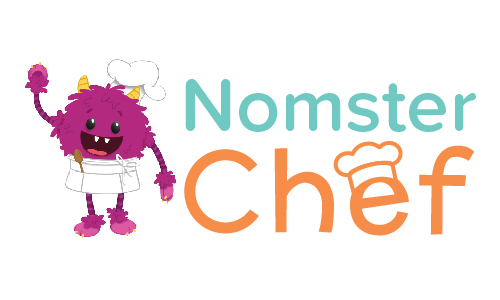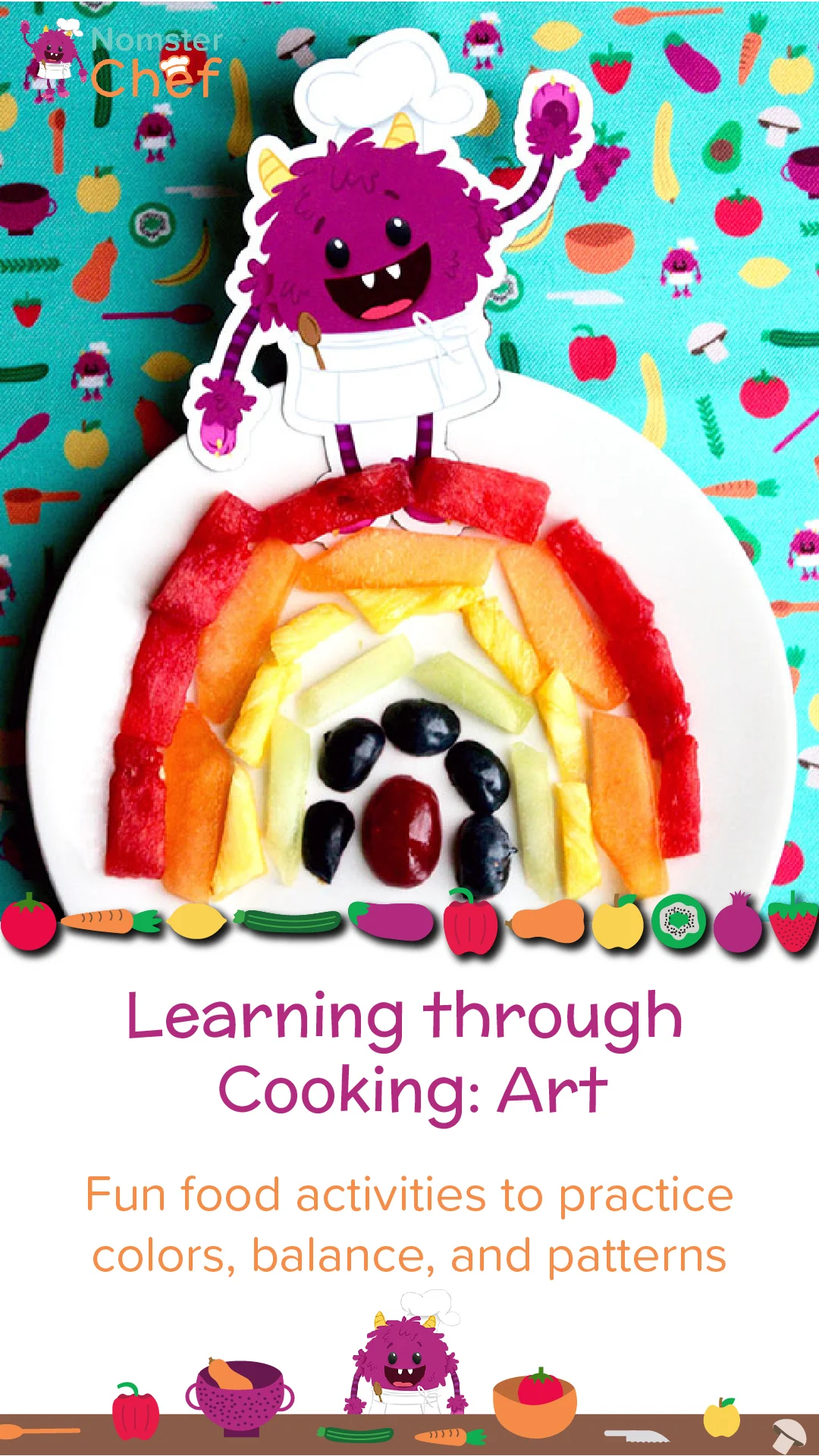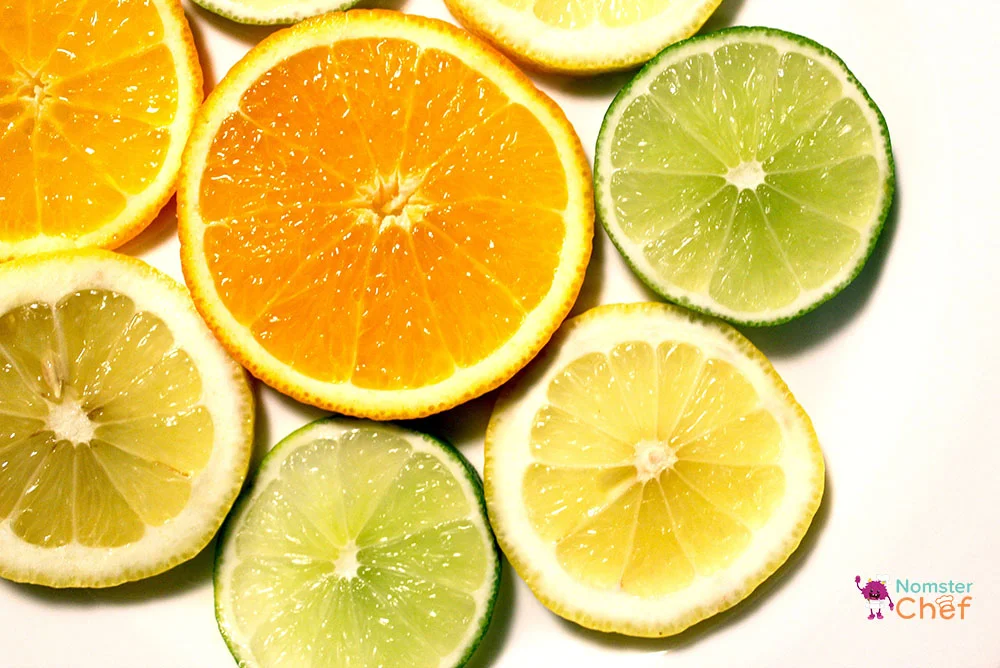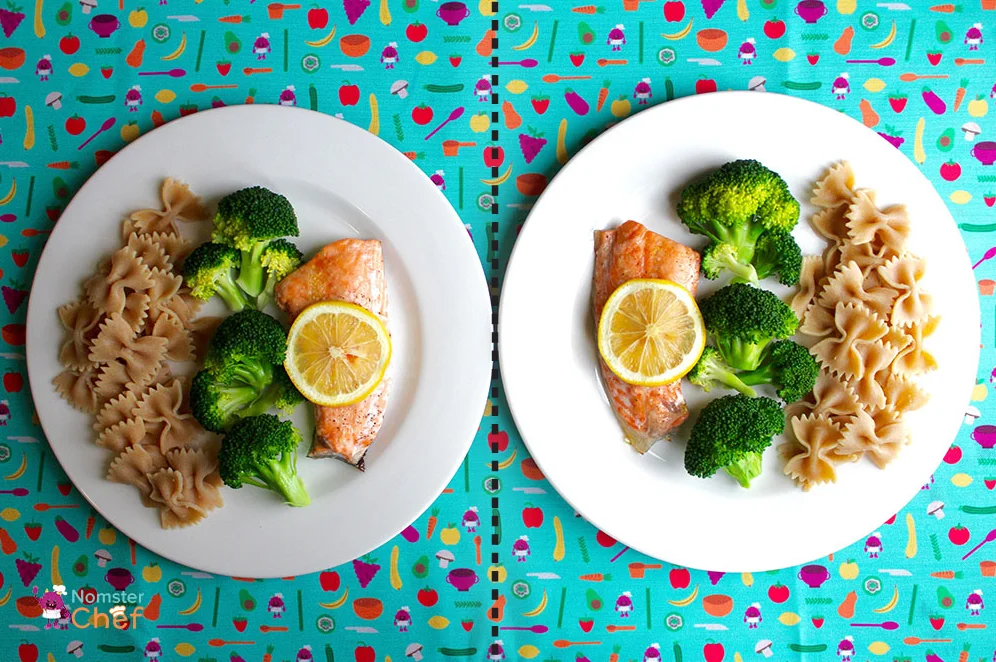Welcome back to our Learning through Cooking series! One of the many benefits of cooking from a young age is that kids can learn so many different things by being in the kitchen. Psychologist and Nomster Chef Curriculum Consultant Jamie Krenn is an expert in “culinary cognition” (1) and she’s explaining the tangible ways kids learn through cooking. We’ve already learned how kids can learn fractions from cooking and how kids can learn problem-solving through cooking. Today we’re going to get crafty and learn how kids can practice art skills in the kitchen. Take it away, Jamie!
Why it's important for art to be in your kitchen
Kids can learn tons of concepts from food. This time, I’ll touch on some art skills – mainly how balance, colors and patterns can apply to food. Art is a fantastic addition to the home kitchen. Art is observably a visual expression both created and occurring naturally in foods. Learning about food through balance, colors and patterns can be helpful to understand how one can make eatables both visually appealing and appetizing.
Cuisine that looks attractive may have a higher likelihood of being consumed by little ones. By pairing two modes of presentation (i.e., visual images and spoken words), the child can process new information (like a new food) with much greater ease (2). With proper guidance, children can see food as not just a tasty experience but as a visually appealing one. Talking about food while eating food and cooking is both an stimulating conversation and healthful way to lower your child’s (and your) food anxiety.
Three art concepts kids can learn through food: Balance, Color & Patterns
Art concept: Color
Our world is full of color. And colors are part of our plates! Parents can provide children with a rainbow of colored foods during every meal construction. Don’t worry, no need to search for the rainbow every shopping trip. Start by asking your kids, “What kinds of colors do you see on your dinner plate tonight?”
By using colors, we can help children to see that food can be visually appealing. If they talk about their food more and describe it in terms of colors and visual images, rather than just how it tastes, it could pique their interests in cooking and eating that much more. Most of us have heard the term “eat the rainbow,” in various health food initiatives or articles. This concept is a great way to introduce to your child the varying array of hues good food has to offer. One way to talk about color outside of the cooking process is to play the “Crunch a Color” game. This card game encourages your child to eat differently-colored foods. Another way to practice learning colors is to sort your groceries is by warm colors like reds, yellows, and oranges and into secondary colors like greens, purples, and blues. Simple activities during your everyday tasks make learning more fun and effective.
Art Concept: Balance
As a fundamental principle of art, balance refers to how the elements such as lines, shapes, colors, textures of a piece are arranged on a visual plane. Or in this case, our plates! The most simple type of balance we can start with his symmetrical balance, or when you draw a line down the middle, both sides are equal. Symmetrical balance can help with plating food for a meal. It also gives children practice in repetition and following directions because they must repeat the process when contrasting a plate or serving for each person.
Another type of balance that can hit the plate is radial balance where elements radiate out in a circular shape from one central point. Radial balance is interesting because our eyes naturally travel to the center of images when it is employed. Radial balance can be talked about with little ones both when plating and observing food. For instance, there is a radial balance in the artichoke below as there is a central focal point the containing vibrant purple and green hues. These balance terms are brilliant talking points for your children while you are buying, planting and plating food.
Art Concept: Patterns
Artists use patterns to create repetition suitable for a decorative design. For instance, shapes or forms can regularly be repeated. You can even do this with a plate as your canvas. Artists often use patterns to create balance by utilizing the repetition of structures (i.e. shapes and objects). Food stylists make careers out of creating patterns in food in order to harmonize plates. They strive to make food look tasty and fresh by incorporating balance and patterns! You and you child can have a hand in making your food look “pretty” on a plate. It’s fun and provides hands-on on experience with recipes!
Fun food activities to practice art skills
Warm & Cool Color Plates
Sort your food on your plate by warm and cool colors. Parents, make plate a with as many colors as possible. (Hint: to complete your rainbow, look for purple potatoes or carrots, and blueberries which are pretty much the only blue food).
Balance Plate for One vs. Balance Plate for All
Have children create a plate for themselves and one for a family member. Have then make both plates balanced side by side. Then, see if they can create a symmetrical plate for one person. This activity is great for fine motor skills, following directions and creating patterns.
Radial Balanced Foods Scavenger Hunt
Find foods at dinner, in the store, or at the local market that achieve radial balance. Keep score. Who can find the most?
Recipes with Patterns
There are lots of recipes that use patterns, and 2 Nomster Blog recipes that are great for creating pattern art with food.
PB&J Sushi: make a strawberry/banana pattern before rolling up the “sushi”
Rainbow Veggie Kabobs: Make a pattern as you place the veggies on the kabobs
Colors, balance and patterns can be learned through food in many places like the home, market or farm. Pairing food with lessons about balance and colors will assist in solidifying food knowledge and help your kids learn more about the culinary world around them. With these helpful suggestions, you and your child can then you can indeed eat, grow and plant a rainbow.
Happy Finding Art in Food, Nomsters!
OTHER POSTS IN THE "LEARNING THROUGH COOKING" SERIES
Learning through Cooking: Problem-Solving
Learning through Cooking: Fractions
Citations
(1) Krenn, J. (2016). Cooking with “Attitude” & “App-titude” Suggestions for Today’s Mobile Media Developers to Help Parents Promote Positive Life-long Skills in the Kitchen. In D. Mentor’s (Ed.) Handbook of Research on Mobile Learning in Contemporary Classrooms. Advances in Mobile and Distance Learning (AMDL) Book Series.
(2) Mayer, R. (2001). A Cognitive Theory of Multimedia Learning. In Mayer, R., Multimedia Learning. New York: Cambridge University Press.
ABOUT THE AUTHOR
Jamie Krenn is a curriculum consultant and contributor to Nomster Chef. She holds a Ph.D. in Educational Psychology: Cognitive Studies from Teachers College, Columbia University. She is a very goofy mother who is unable to resist taco trucks and gooey mac & cheese. Jamie plays with her daughter, Emma each day until she (Jamie) is exhausted. Their snacks of preference are kale, baguettes, and crispy croissants.
ABOUT THE PHOTOGRAPHER
Katie Holzman is a Social Media Marketing Intern for Nomster Chef. She is currently a junior at Ithaca College studying television-radio and marketing. She loves creating food media almost as much as she loves eating, and you can check out more of her work at her blog or @katies_plate on Instagram!
Amazon Link Disclosure: Nomster Chef is a participant in the Amazon Services LLC Associates Program, an affiliate advertising program designed to provide a means for sites to earn advertising fees by advertising and linking to amazon.com. Clicking on these links and making a purchase earns Nomster Chef a small commission, at no additional cost to you. Thanks so much for your support!
















